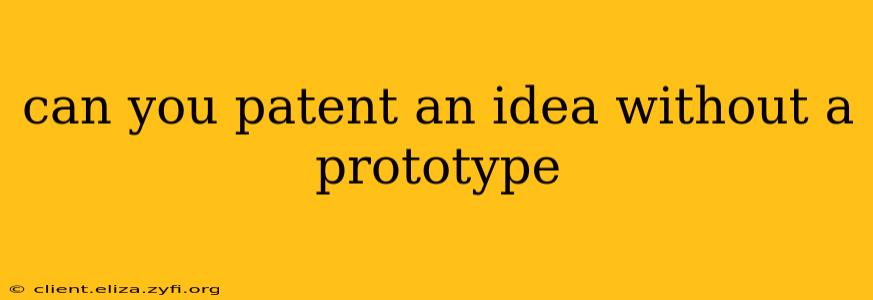Can You Patent an Idea Without a Prototype?
The short answer is: yes, but it's much harder. You can't patent a mere idea; you need to patent an invention. However, that invention doesn't necessarily require a fully functional prototype. A patent application needs to demonstrate that your invention is sufficiently defined and novel to warrant protection, and this can sometimes be done with detailed drawings, specifications, and explanations, even without a physical prototype.
The key is to show that your invention is not just a concept, but a tangible and workable solution to a problem. Think of it as describing a recipe in enough detail that someone skilled in the art could make it without needing you to hold their hand.
Here's a breakdown of what you need to successfully patent an idea without a prototype:
What You Need Instead of a Prototype:
-
Detailed Written Description: This is crucial. Your application needs to clearly explain the invention, its function, and how it works. Think about providing step-by-step instructions, diagrams, and mathematical formulas where applicable. The more detail you provide, the better your chances.
-
Drawings: Technical drawings are frequently essential to visually represent your invention. These drawings should be clear, precise, and comprehensive, leaving no room for ambiguity. A skilled patent draftsman can be invaluable here.
-
Claims: These are the legal boundaries of your patent. They precisely define what aspects of your invention are protected. Claims should be carefully worded to cover the essential features of your invention. This is where legal expertise is especially important.
-
Evidence of Novelty and Non-Obviousness: You need to demonstrate that your invention is new and not an obvious extension of existing technology. This often involves researching prior art (existing patents and publications related to your invention) to show that your invention is unique.
Why a Prototype Is Usually Beneficial:
While not always mandatory, a prototype – even a rudimentary one – provides significant advantages:
-
Proof of Concept: A prototype provides concrete evidence that your invention is feasible and works as intended. This strengthens your application significantly.
-
Improved Understanding: Building a prototype helps you better understand your invention and identify potential flaws or areas for improvement. This can lead to a stronger, more robust patent application.
-
Easier Explanation: A prototype can help you more easily explain your invention to the patent examiner, leading to a smoother and faster approval process.
What if My Idea is Very Complex?
For complex inventions, a working prototype might be practically impossible or prohibitively expensive to create initially. In such cases, you may be able to file a provisional patent application, which gives you a year to further develop your invention and then file a non-provisional application with a more complete description and potentially a prototype.
H2: What if Someone Else Creates a Prototype Based on My Patent Application?
Your patent application is kept confidential until the patent is granted. However, it's crucial to remember that filing a patent application doesn't automatically grant you ownership or protection. Others could potentially develop a similar invention independently during the application process. This is why it's advisable to seek legal counsel and move quickly once you have a solid idea.
H2: How Much Does it Cost to Patent an Idea Without a Prototype?
The cost of obtaining a patent, with or without a prototype, varies significantly based on several factors. These include the complexity of your invention, the jurisdiction where you're filing (international patents can be significantly more expensive), and the fees charged by your patent attorney. Expect to spend thousands of dollars, potentially tens of thousands for more complex inventions and international filings.
In conclusion, while technically possible to patent an idea without a prototype, a comprehensive written description, detailed drawings, and a strong understanding of patent law are essential. Consider seeking professional guidance from a patent attorney to navigate the complexities of the patent process and significantly improve your chances of success.
